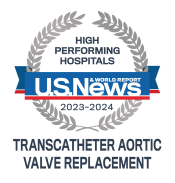Aortic Valve Replacement
While our doctors successfully manage some aortic valve glitches with checkups or medications, more serious leaking (valve regurgitation) or narrowing (valve stenosis) requires aortic valve surgery.
Usually that means we need to replace the valve.
Our doctors offer the latest implantable valves — either through standard surgeries or minimally invasive approaches for our sicker patients and those who prefer a smaller incision.
In the past, we replaced only the most severely diseased aortic valves. However, given the advances in technology and techniques, we now believe a wider group of patients may benefit. We have even operated successfully on patients in their 80s and 90s.
We believe success means more than simply replacing your aortic valve. We make sure your new valve is the best type and size for your individual anatomy and health challenges. Our program accomplishes that with:
- Deep experience: Our lead aortic valve surgeon does hundreds of replacements a year, with the help of a highly experienced team. We receive referrals for complicated aortic valve cases from around the region. These include:
- Redoing replacements if patients later need a coronary artery bypass graft, or CABG
- Operating on patients with long-running valve problems that have caused their hearts to weaken
- Working with our heart failure colleagues to replace valves in heart failure patients, often times avoiding the long-term use of heart pumps
- Teamwork: Our aortic valve team meets weekly, bringing together a range of specialists from different disciplines to help decide who will potentially benefit from surgery.
- Treatment choices: We offer a wide range of valve types and surgical techniques — including catheter-based approaches for patients unable to undergo traditional operations. Our lead surgeon understands the subtleties of valve selection and replacement, and takes the time to explain why a particular valve is recommended.
- Top CABG: Half of patients undergoing valve replacement also require coronary artery bypass grafting (CABG) because of blockage(s). We have a top bypass team and are among the first centers in the mid-Atlantic to offer a minimally invasive, robotic-assisted option. Learn more about our minimally invasive direct coronary artery bypass (MIDCAB) procedure and our totally endoscopic coronary artery bypass (TECAB).
- Leading clinical trials: Our program’s strong reputation allows our center to conduct early evaluations of promising new replacement valves, giving our patients access to options not available elsewhere. We are among select Maryland centers offering a new, suture-free valve that does not require stitching, with smaller incisions and half the normal time spent on a heart-lung machine.
Tissue vs Mechanical Valve
We offer a wide selection of valves, tailored to your condition, anatomy and goals. We constantly look for new, helpful options. We divide valves into two general categories, each with benefits and limits:
- Mechanical valves: Mechanical valves last the longest and avoid the possibility of another replacement. Until recently, we often recommended them to our youngest patients. But the valves require blood thinners, with some patients experiencing a stroke (because the drugs did not work) or severe bleeding (as a side effect).
- Tissue (bioprosthetic) valves: Suppliers create tissue valves from cadavers or animals — mainly from cow hearts but also pigs. Historically, 10 percent of patients needed their tissue valve replaced after 10 years, and 20 percent needed it done after 15 years. However, we increasingly recommend these valves, even for younger patients. The reasons include:
- Increased durability: We expect newer tissue valves to last longer.
- Good outcomes: Data now show that tissue valve replacements effectively relieve symptoms, restore function and protect the heart.
- Safety: Tissue valves do not require blood thinners.
Recovery After Surgery
Patients undergoing aortic valve replacement typically
Minimally Invasive Aortic Valve Replacement
Patients who prefer smaller incisions can ask our doctors about the possibility of minimally invasive surgery. We also offer options for patients who cannot undergo a conventional, open operation:
- Transcatheter replacement: Our doctors use an artery and a long, thin tube (catheter) to reach the heart during a procedure that avoids surgery. Learn more about transcatheter aortic valve replacement, the option we most often recommend.
- Bypass: Our surgeons create a new route for blood, with a new aortic valve. Learn more about aortic valve bypass, a minimally invasive surgery.
- Balloon valvuloplasty: A catheter and a balloon enlarge valves narrowed by stenosis during a non-surgical procedure. Learn more about valvuloplasty.
Aortic Valve Repair
While repair is common and the preferred method for mitral valves, replacement is the standard for aortic valves. By the time a patient needs surgery, the valve is often severely blocked or the flaps (leaflets) are destroyed. The aortic valve is also less forgiving than the mitral valve when it comes to making a tight seal.
We offer aortic valve repair, albeit with a conservative approach that carefully weighs whether replacement is a better option.
Such valve-sparing procedures are an option for some patients with leaky aortic valves or those with an enlarged aorta that has interfered with the valve.

